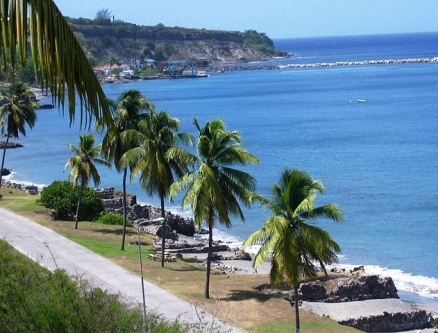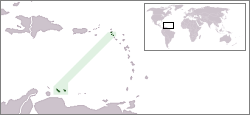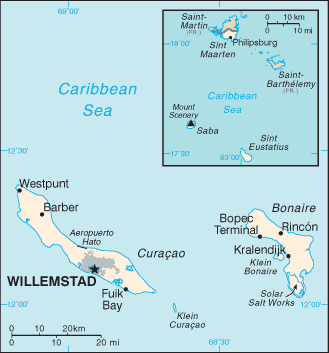Netherlands Antilles
The Netherlands Antilles (or "Dutch Antilles") is a former political entitiy which consisted of five island in two groups in the Caribbean Sea. The southern group of Curacao and Bonaire lie just north of the Venezuelan coast and are members of the so called "Windward Islands."
The northern group, Sint Eustatius, Saba and Sint Maarten, located southeast of the Virgin Islands are members of the so called "Leeward Islands." All five islands are part of the Lesser Antilles island chain of the West Indies.
The island of Saint Martin is the smallest landmass in the world shared by two independent states, the French territory of Saint Martin and the Dutch territory of Sint Maarten
Once the center of the Caribbean slave trade, the island of Curacao was hard hit by the abolition of slavery in 1863. Its prosperity (and that of neighboring Aruba) was restored in the early 20th century with the construction of oil refineries to service the newly discovered Venezuelan oil fields.
The island of Saint Martin is shared with France; its southern portion is named Sint Maarten and is part of the Netherlands Antilles; its northern portion, called Saint Martin, is an overseas collectivity of France.
In October 2010, the Netherlands Antilles was dissolved as a political entities and the three smallest islands - Bonaire, Sint Eustatius, and Saba - became special municipalities in the Netherlands administrative structure.
The citizens of Sint Maarten and Curacao voted to become a self-governing countries within the Kingdom of the Netherlands. The change in status became effective in October of 2010 with the dissolution of the Netherlands Antilles.
Contents
Geography
Location: Caribbean, two island groups in the Caribbean Sea - composed of five islands, Curacao and Bonaire located off the coast of Venezuela, and Sint Maarten, Saba, and Sint Eustatius lie east of the US Virgin Islands
Geographic Coordinates:
- Bonaire: 12 12 N, 68 15 W
- Curacao: 12 10 N, 69 00 W
- Saba: 17 38 N, 63 14 W
- Sint Eustatius: 17 30 N, 62 58 W
- Sint Maarten: 18 04 N, 63 04 W
Area: 960 sq km
arable land: 10%
permanent crops: 0%
other: 90% (2005)
Land Boundaries: 15 km with the French part of the island of Saint Martin
Coastline:364 km
Maritime Claims: Territorial sea to 12 nautical miles and an exclusive fishing zone to 12 nautical miles
Natural Hazards:Sint Maarten, Saba, and Sint Eustatius are subject to hurricanes from July to October; Curacao and Bonaire are south of Caribbean hurricane belt and are rarely threatened
Terrain: Generally hilly, volcanic interiors. The highest point isMount Scenery (862 m).
Climate: Tropical; ameliorated by northeast trade winds
Capital: Willemstad (on Curacao)
Ecology and Biodiversity
Biological diversity in the Caribbean Islands
The islands of Aruba, Curaçao, and Bonaire (sometimes called the A-B-C’s) fall within the Aruba-Curaçao-Bonaire cactus scrub ecoregion. This dry desert scrub ecoregion receives little rainfall. A haven for avifauna, over two hundred bird species are found here, many of which are endangered. Tourism is a major threat to this habitat as development for. Also, feral goats and sheep destroy much of the natural vegetation through overgrazing.
Saba and Sint Maarten are within the Caribbean Shrublands ecoregion.
Sint Eustatius is within the Lesser Antillean Dry Forests ecoregion.
See also: Caribbean Sea large marine ecosystem
People and Society
Population:227,049 (July 2009 est.)
Age Structure:
0-14 years: 22.7% (male 26,429/female 25,162)
15-64 years: 67.7% (male 74,183/female 79,434)
65 years and over: 9.6% (male 8,875/female 12,966) (2009 est.)
Population Growth Rate:0.732% (2009 est.)
Birthrate:14.37 births/1,000 population (2008 est.)
Death Rate:6.43 deaths/1,000 population (2008 est.)
Net Migration Rate:-0.39 migrant(s)/1,000 population (2009 est.)
Life Expectancy at Birth: 76.65 years (2009 est.)
Total Fertility Rate:1.97 children born/woman (2009 est.)
Languages:Papiamento 65.4% (a Spanish-Portuguese-Dutch-English dialect), English 15.9% (widely spoken), Dutch 7.3% (official), Spanish 6.1%, Creole 1.6%, other 1.9%, unspecified 1.8% (2001 census)
Literacy: 96.7% (2003 est.)
Energy
See Energy profile
Economy
Tourism, petroleum refining, and offshore finance are the mainstays of this small economy, which is closely tied to the outside world. Although Gross Domestic Product (GDP} has declined or grown slightly in each of the past eight years, the islands enjoy a high per capita income and a well-developed infrastructure compared with other countries in the region. Most of the oil Netherlands Antilles imports for its refineries come from Venezuela. Almost all consumer and capital goods are imported, the US, Italy, and Mexico being the major suppliers. Poor soils and inadequate water supplies hamper the development of agriculture. Budgetary problems hamper reform of the health and pension systems of an aging population. The Netherlands provides financial aid to support the economy.
GDP: (Purchasing Power Parity):$2.8 billion (2004 est.)
GDP-real growth rate:1% (2004 est.)
GDP- per capita (PPP):$16,000 (2004 est.)
GDP- composition by sector:
agriculture: 1%
industry: 15%
services: 84% (2000 est.)
Industries: tourism (Curacao, Sint Maarten, and Bonaire), petroleum refining (Curacao), petroleum transshipment facilities (Curacao and Bonaire), light manufacturing (Curacao)
Natural Resources:phosphates (Curacao only), salt (Bonaire only)
Currency: Netherlands Antillean guilders (ANG)


